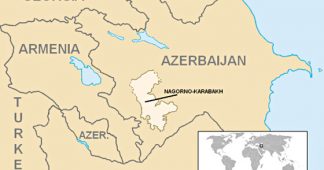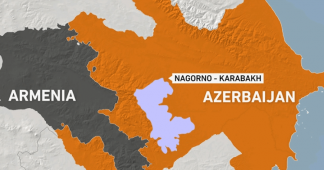The battle over Nagorno-Karabakh, waged on and off for a century, has flared a new and civilians once again suffer the consequences
by Bethan McKernan in Stepanakert.
Pictures by Achilleas Zavallis
Over the road from the 8-metre-deep crater left by a medium-range missile, Sergei Hovhnnesyan and three of his neighbours are hunkering down in the basement storage space of their local grocery shop in Stepanakert, a mountain town in the heart of the Nagorno-Karabakh territory claimed by both Armenia and Azerbaijan.
Whenever there is a gap in the airstrikes and shelling, their elderly legs make the trip up the stairs to bring down enough provisions to survive what could turn into a siege as the two ex-Soviet neighbours go to war once again.
About 70,000 Armenians in Nagarno-Karabakh have fled the poorly aimed Azerbaijani rockets and drones, which appear to have hit civilian neighbourhoods more often than infrastructure and military bases. Those who stay – many of them from older generations like Sergei and his friends – say they would rather die than abandon their homes to Azerbaijan.
Updates on the fighting arrive via the chime of WhatsApp messages and news bulletins on the radio, while the Diocese still holds mass for people who dare to go to church to pray and light candles.
When the air raid siren sounds to warn that an Azerbaijani jet has crossed into Armenian-controlled airspace, residents have approximately three minutes to find cover. Sometimes, when the Russian-made missile defence systems don’t work, there is no warning at all.
Armenia’s vast diaspora has mobilised to help the tiny country in the battle against Azerbaijan, with volunteers from France, the US and Lebanon arriving by the planeload. In the 1990s, they were joined by Russian, Ossetian and Slavic mercenaries, while Baku was assisted by Turkish far-right group, the Grey Wolves, as well as men from Chechnya and Afghanistan.
Read more atwww.theguardian.com/artanddesign/2020/oct/13











